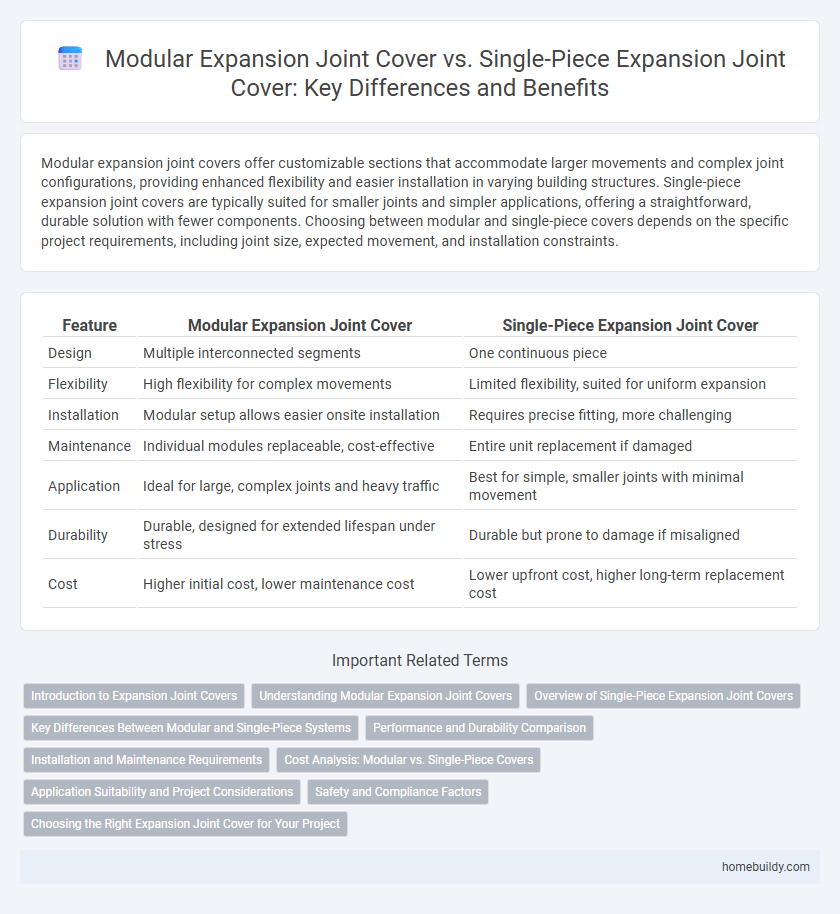Modular expansion joint covers offer customizable sections that accommodate larger movements and complex joint configurations, providing enhanced flexibility and easier installation in varying building structures. Single-piece expansion joint covers are typically suited for smaller joints and simpler applications, offering a straightforward, durable solution with fewer components. Choosing between modular and single-piece covers depends on the specific project requirements, including joint size, expected movement, and installation constraints.
Table of Comparison
| Feature | Modular Expansion Joint Cover | Single-Piece Expansion Joint Cover |
|---|---|---|
| Design | Multiple interconnected segments | One continuous piece |
| Flexibility | High flexibility for complex movements | Limited flexibility, suited for uniform expansion |
| Installation | Modular setup allows easier onsite installation | Requires precise fitting, more challenging |
| Maintenance | Individual modules replaceable, cost-effective | Entire unit replacement if damaged |
| Application | Ideal for large, complex joints and heavy traffic | Best for simple, smaller joints with minimal movement |
| Durability | Durable, designed for extended lifespan under stress | Durable but prone to damage if misaligned |
| Cost | Higher initial cost, lower maintenance cost | Lower upfront cost, higher long-term replacement cost |
Introduction to Expansion Joint Covers
Expansion joint covers are essential components designed to bridge gaps in structures, accommodating thermal movement and seismic activities to ensure structural integrity. Modular expansion joint covers consist of multiple interconnected segments, providing enhanced flexibility and easier installation in complex or large-scale applications. Single-piece expansion joint covers offer a streamlined design ideal for smaller joints, delivering robust protection with simpler maintenance requirements.
Understanding Modular Expansion Joint Covers
Modular expansion joint covers consist of multiple interconnected components that allow for greater flexibility and easier customization to accommodate various structural movements and joint sizes. Unlike single-piece expansion joint covers, modular systems offer enhanced durability and simplified maintenance by enabling the replacement of individual modules without disturbing the entire assembly. These features make modular expansion joint covers ideal for large infrastructure projects where adaptability and long-term performance are critical.
Overview of Single-Piece Expansion Joint Covers
Single-piece expansion joint covers provide a seamless design ideal for bridging smaller gaps in floors or walls, ensuring effective protection against debris and moisture infiltration. Constructed from a single continuous material, these covers offer ease of installation and low maintenance, suitable for light to moderate movement areas. Their durability and simplicity make them a cost-effective solution for environments with minimal thermal expansion or structural vibration.
Key Differences Between Modular and Single-Piece Systems
Modular expansion joint covers consist of multiple interlocking components that allow for greater flexibility and easier installation in large or complex structures, while single-piece expansion joint covers are manufactured as one solid unit optimized for smaller gaps and simpler applications. Modular systems offer enhanced adaptability to multi-directional movement and thermal expansion, whereas single-piece covers provide a more streamlined design with fewer potential points of failure. Maintenance and repair are typically more cost-effective with modular covers, as individual sections can be replaced independently without removing the entire assembly.
Performance and Durability Comparison
Modular expansion joint covers offer superior performance and durability due to their segmented design, which allows for better accommodation of thermal movements and structural shifts without compromising integrity. Single-piece expansion joint covers, while simpler to install, often face limitations in handling large deformations, leading to faster wear and potential failure under extreme stress conditions. The modular system's enhanced flexibility and load distribution capabilities result in extended service life and reduced maintenance compared to single-piece alternatives.
Installation and Maintenance Requirements
Modular expansion joint covers offer easier installation due to their segmented design, allowing flexible fitting around complex structures, whereas single-piece expansion joint covers require precise measurements and space for handling during installation. Maintenance of modular covers is more convenient because individual sections can be replaced or repaired without removing the entire cover, while single-piece covers often necessitate full removal for any repairs, increasing downtime. Both types demand regular inspection to ensure joint integrity, but modular systems reduce labor intensity and costs associated with maintenance activities.
Cost Analysis: Modular vs. Single-Piece Covers
Modular expansion joint covers often incur higher initial costs due to complex installation and multiple components, but they offer reduced maintenance expenses and easier part replacement, leading to long-term savings. Single-piece expansion joint covers have lower upfront costs and simpler installation but may require costly full replacements or repairs when damaged. Evaluating total life-cycle expenses reveals modular covers as more cost-effective in applications with frequent movement or harsh conditions.
Application Suitability and Project Considerations
Modular expansion joint covers offer superior application suitability for large or complex structures due to their adaptability and ease of installation in segmented sections, allowing for tailored fit and better accommodation of building movement. Single-piece expansion joint covers are ideal for smaller projects with straightforward joint designs, providing a more cost-effective and simpler solution where expansion movement is limited. Project considerations such as joint width, movement range, load requirements, and installation access heavily influence the choice between modular and single-piece covers, ensuring optimal performance and durability.
Safety and Compliance Factors
Modular expansion joint covers offer enhanced safety by allowing for easier inspection and maintenance, reducing the risk of structural failure and ensuring ongoing compliance with building codes. Single-piece expansion joint covers can present challenges in addressing localized damage, potentially compromising safety standards if defects go unnoticed. Choosing modular designs supports adherence to safety regulations through improved accessibility and adaptability to structural movements.
Choosing the Right Expansion Joint Cover for Your Project
Modular expansion joint covers offer enhanced flexibility and adaptability for complex structures, allowing individual components to be replaced without disturbing the entire system. Single-piece expansion joint covers provide a cost-effective and straightforward solution for projects with limited movement and simpler architectural requirements. Selecting the right expansion joint cover depends on factors such as building movement, durability needs, maintenance accessibility, and budget constraints tailored to the project's specific structural demands.
Modular expansion joint cover vs Single-piece expansion joint cover Infographic

 homebuildy.com
homebuildy.com